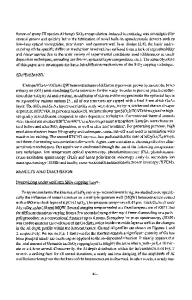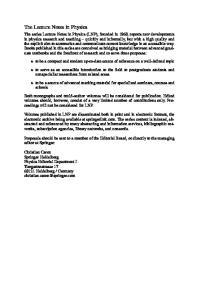Thermal Annealing of InGaN/GaN Strained-Layer Quantum Well
- PDF / 751,111 Bytes
- 6 Pages / 417.6 x 639 pts Page_size
- 27 Downloads / 300 Views
be presented. The effects of intermixing on the confinement potential of InGaN/GaN QWs have been theoretically analysed, with sublattices interdiffusion as the basis. This process is described by Fick's law, with constant diffusion coefficients in both the well and the barrier layers. The diffusion coefficients depend on the annealing temperature, time and the activation energy of constituent atoms. The optical properties of intermixed InGaN/GaN QW structure of different interdiffusion rates have been theoretically analyzed for applications of novel optical devices. The photoluminescence studies and the intermixed QW modeling have been used to understand the effects of intermixing. INTRODUCTION Wide-bandgap semiconductors such as GaN, AIN, InN and their ternary compounds have been studied so as to realize the semiconductor blue-green laser. As a matter of fact, the demonstration of high-brightness blue-green light-emitting diodes from the wurtzite GaN semiconductor has stimulated a lot of research on the fabrication of blue-green laser diodes using nitride-based semiconductors [1-3]. InGaN/GaN single-quantum-well structures have been used to achieve high-power blue and green light-emitting diodes. Also, room temperature pulsed lasing of a strained InGaN/GaN multiquantum-well laser diode has recently been demonstrated. The nature crystal structure of most of the group III nitrides is wurtzite. Strain is also present in most of the group III nitrides because of the lack of substrate materials with a matched G 6.25 Mat. Res. Soc. Symp. Proc. Vol. 537 © 1999 Materials Research Society
lattice constant and a thermal expansion coefficient. Indeed, fundamental studies of the effects of strain on wurtzite band structure play an important role in understanding the electronic and optical properties of GaN-based optoelectronic materials and devices. In order to tune the interesting wavelength, the concept of band-gap engineering is a useful tool to accept the particular devices operation [4]. Basically, intermixing process is one of easy way to achieve the modification of bandstructure. The intermixing process involves the interdiffusion of the constituent atoms of the heterostructure, the process temperature, and time. During the process the as-grown square-QW compositional profile is modified to a graded profile thereby altering the confinement profile and subband structure in the QW. The interdiffusion of InGaN/GaN QW system is more complex compared with AlGaAs/GaAs and InGaAs/GaAs because of the immiscibility of InN and GaN [5]. THEORETICAL MODEL This paper presents a theoretical study of the effects of interdiffusion on a 25A well/70A barrier of an In 0.2Ga 0.8N/GaN MQW structure, whose properties leads to the shift in spontaneous emission rate. The effects of interdiffusion on the strains, the splitting of the heavy-hole (HH), the light-hole (LH), the crystal-field split-hole (CH) subbands, the conduction band (CB) and their dispersions, are calculated theoretically, based on the Hamiltonian derived using the multi-ba
Data Loading...











